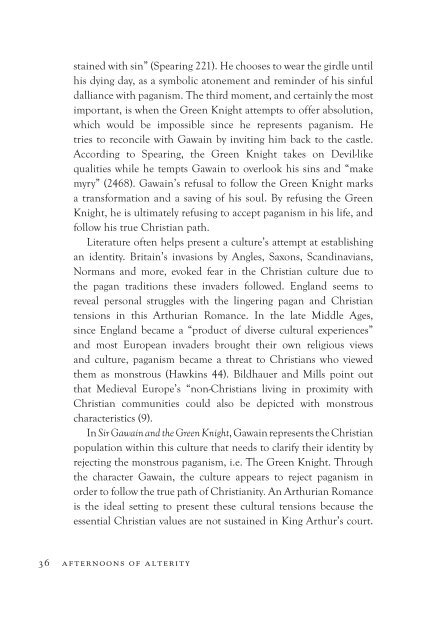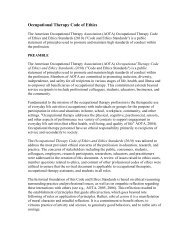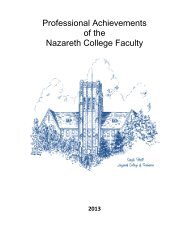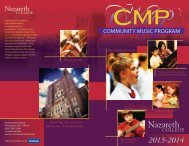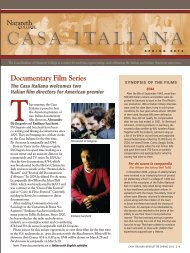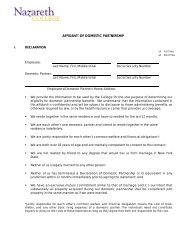Afternoon of Alterity - Nazareth College
Afternoon of Alterity - Nazareth College
Afternoon of Alterity - Nazareth College
Create successful ePaper yourself
Turn your PDF publications into a flip-book with our unique Google optimized e-Paper software.
stained with sin” (Spearing 221). He chooses to wear the girdle untilhis dying day, as a symbolic atonement and reminder <strong>of</strong> his sinfuldalliance with paganism. The third moment, and certainly the mostimportant, is when the Green Knight attempts to <strong>of</strong>fer absolution,which would be impossible since he represents paganism. Hetries to reconcile with Gawain by inviting him back to the castle.According to Spearing, the Green Knight takes on Devil-likequalities while he tempts Gawain to overlook his sins and “makemyry” (2468). Gawain’s refusal to follow the Green Knight marksa transformation and a saving <strong>of</strong> his soul. By refusing the GreenKnight, he is ultimately refusing to accept paganism in his life, andfollow his true Christian path.Literature <strong>of</strong>ten helps present a culture’s attempt at establishingan identity. Britain’s invasions by Angles, Saxons, Scandinavians,Normans and more, evoked fear in the Christian culture due tothe pagan traditions these invaders followed. England seems toreveal personal struggles with the lingering pagan and Christiantensions in this Arthurian Romance. In the late Middle Ages,since England became a “product <strong>of</strong> diverse cultural experiences”and most European invaders brought their own religious viewsand culture, paganism became a threat to Christians who viewedthem as monstrous (Hawkins 44). Bildhauer and Mills point outthat Medieval Europe’s “non-Christians living in proximity withChristian communities could also be depicted with monstrouscharacteristics (9).In Sir Gawain and the Green Knight, Gawain represents the Christianpopulation within this culture that needs to clarify their identity byrejecting the monstrous paganism, i.e. The Green Knight. Throughthe character Gawain, the culture appears to reject paganism inorder to follow the true path <strong>of</strong> Christianity. An Arthurian Romanceis the ideal setting to present these cultural tensions because theessential Christian values are not sustained in King Arthur’s court.36 afternoons <strong>of</strong> alterity


